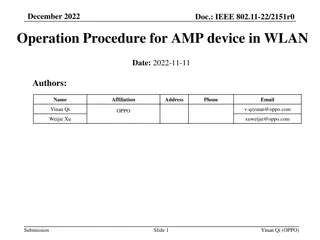High-Level Thoughts on Integrated mmWave Communication for WLAN Solutions
Market demands for WLAN solutions supporting high throughput and low latency applications have led to the development of Integrated mmWave (IMMW). This project focuses on integrating the mmwave band with sub-7GHz links to overcome range, mobility, and reliability challenges. IMMW aims to harmonize designs across the 60 GHz and 45 GHz bands while prioritizing simplicity, power efficiency, and robust link performance. The MAC layer includes features for seamless offloading between mmWave and sub-7GHz links, enhancing beam search processes, and optimizing spectrum utilization for efficient payload delivery.
Download Presentation

Please find below an Image/Link to download the presentation.
The content on the website is provided AS IS for your information and personal use only. It may not be sold, licensed, or shared on other websites without obtaining consent from the author.If you encounter any issues during the download, it is possible that the publisher has removed the file from their server.
You are allowed to download the files provided on this website for personal or commercial use, subject to the condition that they are used lawfully. All files are the property of their respective owners.
The content on the website is provided AS IS for your information and personal use only. It may not be sold, licensed, or shared on other websites without obtaining consent from the author.
E N D
Presentation Transcript
November 2023 doc.: IEEE 802.11-23/1905r0 High Leve Thoughts on IMMW Date: 2023-11-12 Authors: Name Affiliations Address Phone email Bin Tian Qualcomm btian@qti.qualcomm.com George Cherian Rolf De Vegt Abhishek Patil Lin Yang Sameer Vermani Submission Slide 1 Bin Tian (Qualcomm)
November 2023 doc.: IEEE 802.11-23/1905r0 Overview Market trend demands WLAN solutions to support emerging high throughput and/or low latency applications, especially for high density device deployment in both enterprise and home environments XR, gaming, wireless display, device sharing/collaboration, etc. mmwave band has many attractive advantages Abundant spectrum available in most geographical regions Directional transmission and large propagation loss lead to low interference level and more reuse opportunities New integrated mmwave (IMMW) project needs to learn from past mmwave projects and defines its scope to focus on Integrated with sub-7GHz link to overcome the range, mobility and reliability challenges Minimizing the complexity and add-on cost from sub-7GHz support Enhancing link robustness and low latency performance Submission Slide 2 Bin Tian (Qualcomm)
November 2023 doc.: IEEE 802.11-23/1905r0 Band Support IMMW needs to support both 60 GHz and 45 GHz band But designs need to be harmonized across two bands Country Spectrum (GHz) EIRP Limit Notes USA, Canada 57-71 40dBm (avg)/43dBm/(peak) Europe/CEPT 57-71 40dBm (avg) Japan, South Korea, Singapore, Austria, New Zealand, Southeast Asia 57-66 Mexico, Brazil 57-64 China 59-64 44dBm(avg)/47dBm(peak) Currently on hold 42.3-49 36dBm (peak) With 1080 or 540MHz channelization Submission Slide 3 Bin Tian (Qualcomm)
November 2023 doc.: IEEE 802.11-23/1905r0 Thoughts on IMMW PHY The highest design priorities: reduce complexity and power consumption Leverage sub-7GHz PHY design Enable baseband hardware reuse and minimize add-on cost Not chasing peak data rates. Few hundreds of Mbps to 1.5Gbps PHY rate can satisfy the need of most applications One or two bandwidth modes are enough. E.g. 320 and 640MHz Focus on the most useful MCSs (e.g. up to 16QAM) 60/45GHz band has abundant spectrum but generally power limited. Higher order QAM is not a good trade off Higher phase noise in 60GHz/45GHz band also makes it more challenging to support high MCSs Single spatial stream. Open to discussion if more spatial stream is needed Single user transmission only Submission Slide 4 Bin Tian (Qualcomm)
November 2023 doc.: IEEE 802.11-23/1905r0 Thoughts on IMMW MAC Leverage 11be MLO architecture Include mmwave link as part of MLO along with other sub7 links Seamless offloading to Sub-7 during inadequate mmwave coverage Minimize the management frames in this band Conduct discovery, authentication, and other management procedures on sub7GHz links Helps to fully utilize the spectrum for delivering the payload Enhance beam search process and management Assistance from sub-7 links for faster beam search Utilize baseline mechanisms with added rules for reducing MAC inefficiencies Utilize the triggered mode operation with added rules (say, MU EDCA=0) Utilize TWT framework to improve power-save, and scheduling Make the band suitable for predictable latency operations Submission Slide 5 Bin Tian (Qualcomm)
November 2023 doc.: IEEE 802.11-23/1905r0 Summary IMMW project has an opportunity to design new mmwave solutions to utilize the abundant spectrum and address market need However, the commercial success of IMMW technology depends on whether complexity, cost and power consumption are given high priorities in the design IMMW SG needs to define the project scope to reflect these priorities We shared some high-level thoughts on the PHY and MAC directions Submission Slide 6 Bin Tian (Qualcomm)
doc.: IEEE 802.11-23/1905r0 References 22/0481, Integrated mmWave study group formation, Rolf de Vegt (Qualcomm) 22/0046, Next generation after 802.11be, Laurent Cariou (Intel) 22/1083, Next Generation SG formation, Ming Gan (Huawei) 22/1395, Thoughts on high frequency band, Myeongjin KIM (Samsung) 22/1580, a Perspective On Proposed Uhr Features For Enterprise Use Cases, Brian Hart (Cisco) 22/1398, RR-TAG mmWave Spectrum Survey, Rich Kennedy (Unlicensed Spectrum Advocates) 22/1466, Potential PHY Features for UHR, Eunsung Kim (LG) 22/1865, Considerations on the PHY for 60 GHz, Miguel Lopez (Ericsson) 22/1872, Considerations on PHY Designs for mmWave Band, Eunsung Park (LG) 22/1884, mmWave operation for UHR, Laurent Cariou (Intel) 23/0066, Thoughts on Utilizing mmWave, Mengshi Hu (Huawei) Submission Slide 7 Bin Tian (Qualcomm)























